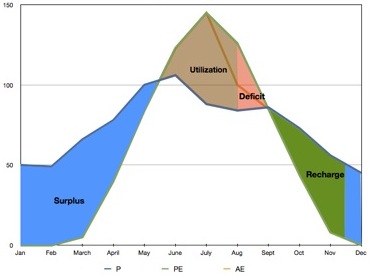10.3.2: Soil Moisture Seasons
- Page ID
- 16116
Four soil moisture seasons can be defined by the soil moisture conditions.

Recharge
The recharge season is a time when water is added to soil moisture storage (+ΔST). The recharge period occurs when precipitation exceeds potential evapotranspiration but the soil has yet to reach its field capacity.
Surplus
The surplus season occurs when precipitation exceeds potential evapotranspiration and the soil has reached its field capacity. Any additional water applied to the soil runs off. If this water runs off into nearby streams and rivers it could cause flooding. Thus, the intensity (amount) and duration (length of season) of surplus can be used to predict the severity of potential flooding.
Utilization
The utilization season is a time when water is withdrawn from soil moisture storage (-ΔST). The utilization period occurs when potential evapotranspiration exceeds precipitation but soil storage has yet to reach 0 (dry soil).
Deficit
The deficit season occurs when occurs when potential evapotranspiration exceeds precipitation and soil storage has reached 0. This is a time when there is essentially no water for plants. Farmers then tap ground water reserves or water in nearby streams and lakes to irrigate their crops. Thus, the intensity (amount) and duration (length of season) of deficit can be used to predict the need for irrigation water.
Whether a place experiences all four seasons depends on the climate and soil properties. Wet climate and those places with soils having high field capacities are less likely to experience a deficit period. Likewise the duration and intensity of any season will be determined by the climate and soil properties. Given equal amounts of precipitation, coarse textured soils will generate runoff faster than fine textured soils and may experience more intense surplus


